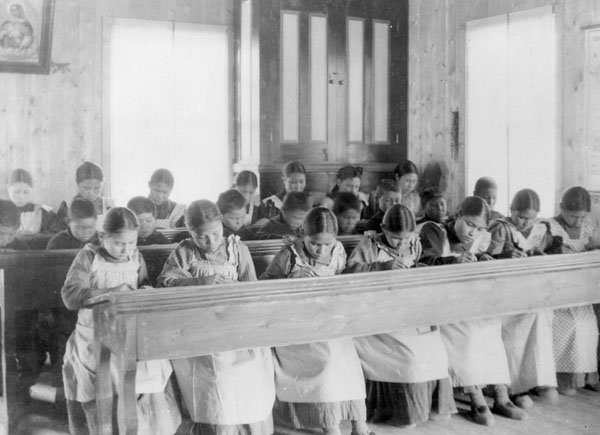
An Act to Encourage the Gradual Civilization of the Indian Tribes in the Province was passed by the fifth Parliament of the Province of Canada (formally Upper Canada and Lower Canada) in 1857. The Gradual Civilization Act, as it came to be known, was part of a state effort to use government policy to assimilate Indigenous peoples to the economic and social customs of European settler society.
The Gradual Civilization Act sought to assimilate Indigenous peoples (then referred to as “Indians”) by encouraging enfranchisement, and adherence to the European concept of private land ownership and wealth accumulation. Under the Act, a debt-free, “educated Indian,” who was of “good moral character,” could apply for a land grant from the federal government. At the time, colonial administrators believed that Indigenous people would benefit from individualized property rights, despite provisions in the Royal Proclamation of 1763 (issued by King George III), which recognized Indigenous land rights. Indigenous people were expected to relinquish their treaty rights voluntarily, to be replaced by land parcelled out for homesteading and voting privileges, which were already constrained under the restrictive definitions of who was eligible to participate in full citizenship rights at the time.
There was internal debate between the respective colonies in British North America on how to best deal with the issue of Indigenous peoples and their ancestral rights. Some historians have argued that civilization did not necessarily mean assimilation for colonial administrators. Ultimately, the British policy of “civilization” was a result of cost and expediency. However, some historians argue that cost was not necessarily the main motivation for defining who was an “Indian” or civilization policy. In pursuing an official act of enfranchisement in 1857, the colonial arm of the British Empire sought to remove the rights of Indigenous peoples, and aimed to set a framework by which this diverse population might be culturally absorbed, or assimilated, into settler populations.
The Gradual Civilization Act served as one indicator of the expansionist agenda of the growing Canadian state, which was on the verge of federation in the late 1850s. The 1857 Act set a precedent for further paternalistic laws, like the Gradual Enfranchisement Act of 1869, which also sought to regulate Indigenous self-determination. These Acts would be consolidated under the Indian Act in 1876, which subsumed existing imperial laws and officially sidestepped the rights of Indigenous peoples under the Royal Proclamation of 1763. The fact that only one person voluntarily franchised under the Gradual Civilization Act suggests that Indigenous response to the colonial law was unfavourable. Efforts to assimilate Indigenous peoples to Euro-Canadian culture were always met with resistance on behalf of Indigenous people and their communities.
The Gradual Civilization Act, the treaty system, and other pre- and post-Confederation laws have been heavily criticized for their coercive nature, inherent racism and lack of regard for the sovereignty of Indigenous peoples, who were widely diverse in their political, economic and culture practices across the continent. This Act, and other policies like it, treated Indigenous people like children, seeking to diminish their power in order to fulfill the expansionist desires of the growing Canadian state. Many have argued, among them Indigenous peoples, historians and critical theorists, that the larger effort to strip Indigenous peoples of their rights under these repressive policies represented cultural genocide. Residential schools are considered one of the many tragic and damning examples of efforts to purge Indigenous identity to serve the purposes of Canadian state formation.

The Gradual Civilization Act was one of the concluding acts of the British imperial administration over their remaining colonies in North America, which had become a costly burden for the ageing empire. In the concert of colonization, strains of liberal humanitarianism informed paternalistic efforts to script Indigenous communities to act in accordance with the concept of Christian agriculturalist settlement. This law reflects the nature of colonial policies seeking to discourage Indigenous peoples from expressing their social and cultural customs and values. This coercive policy of “civilization” would be pursued by the state and society — government officials, Christian missionaries and regular citizen — well into the 20th century, and would result in the loss and shaming of some of the constitutive parts of Indigenous identity and social cohesion.